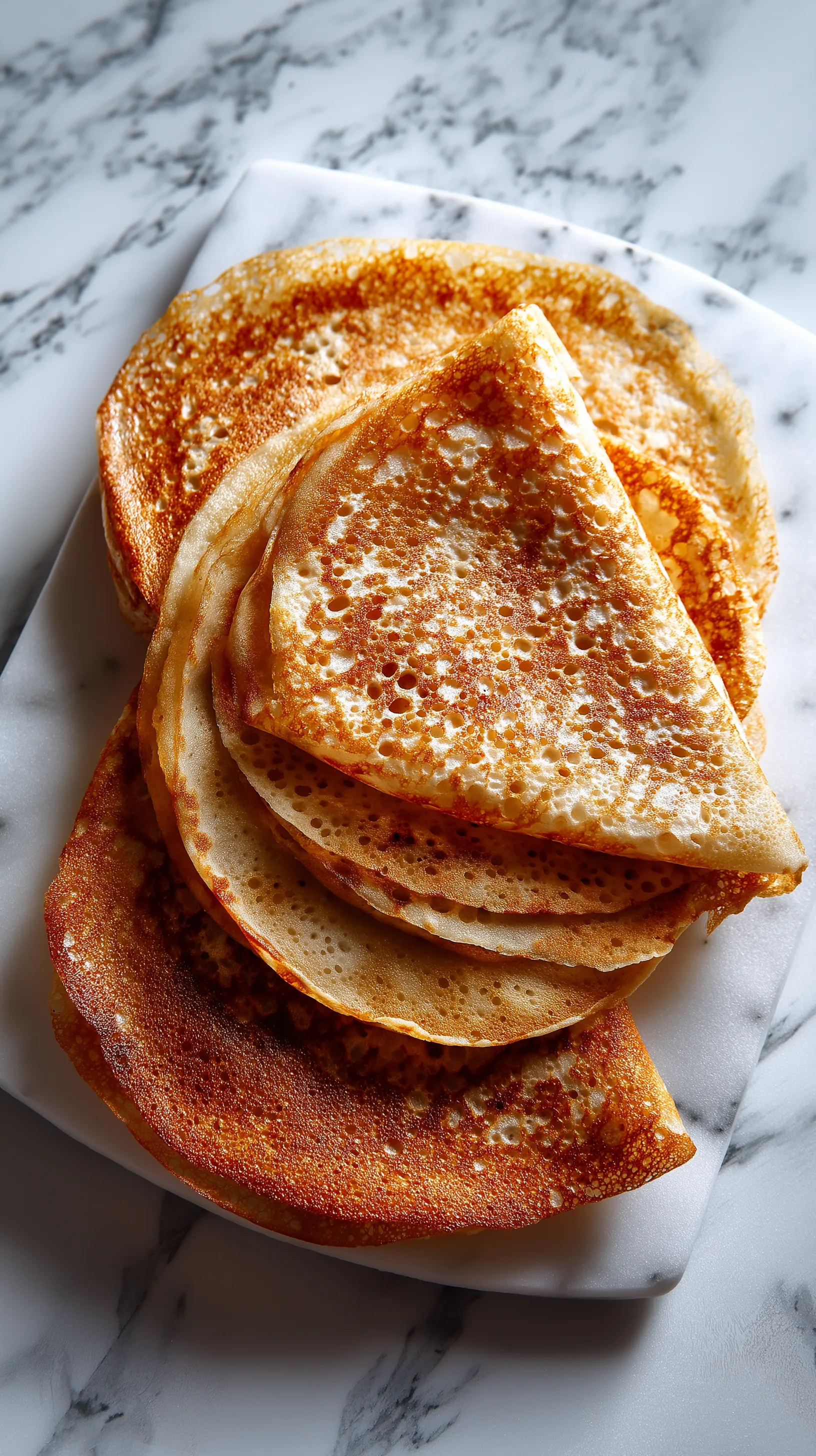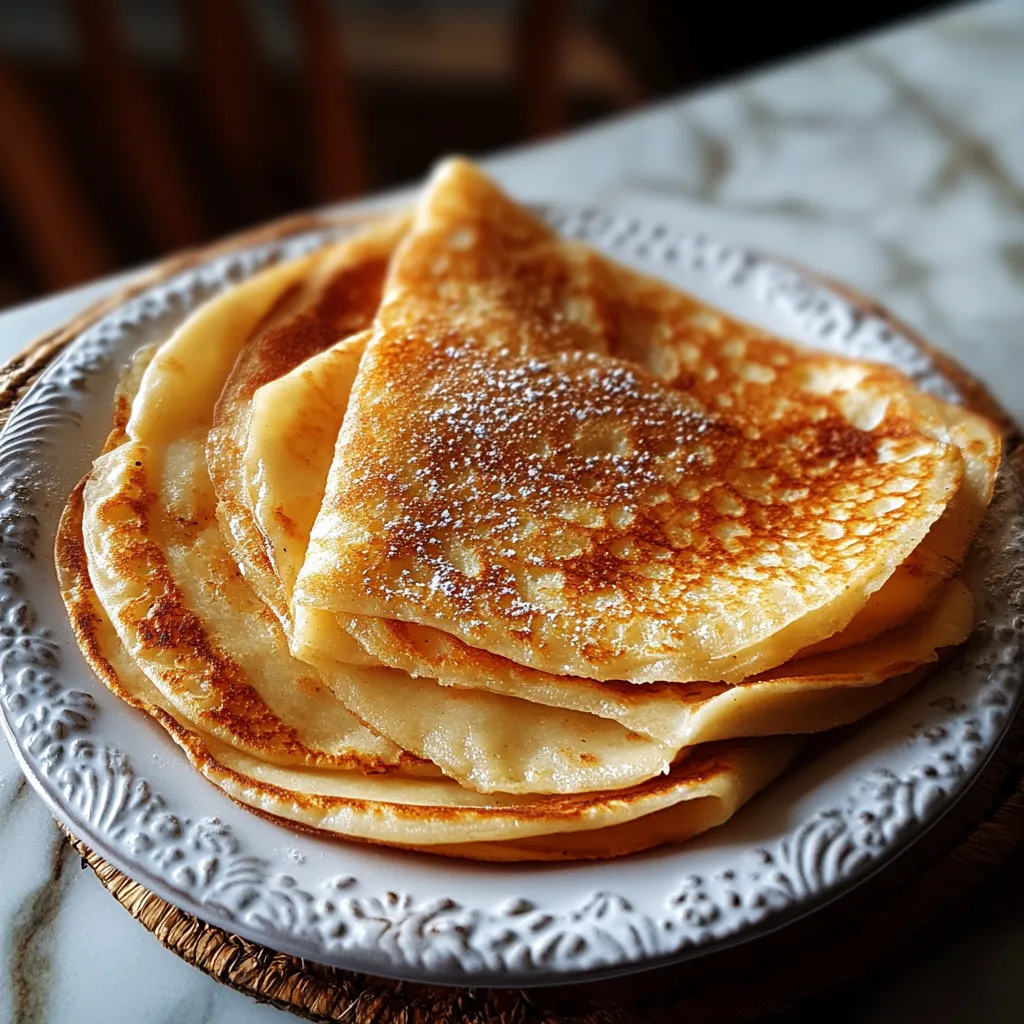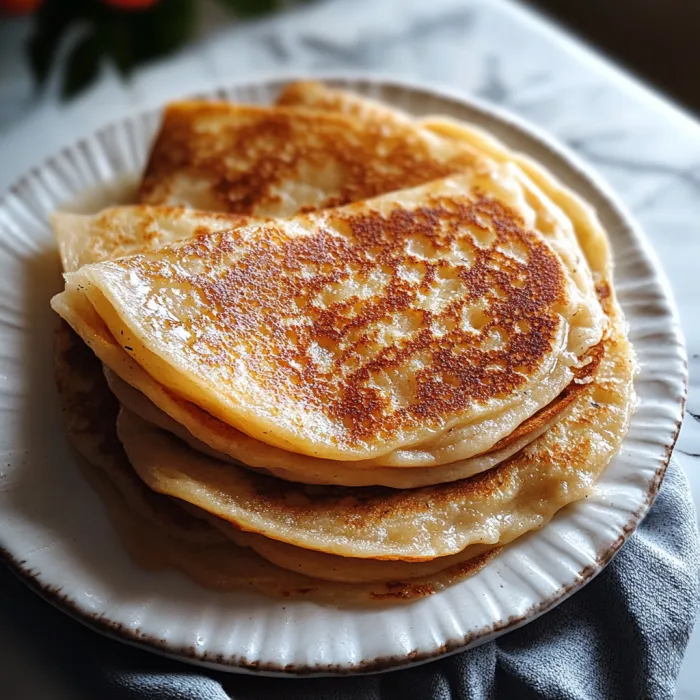 Save
Save
This traditional Galician filloa recipe brings authentic Spanish cuisine right to your kitchen. Lighter than pancakes yet more substantial than crepes, filloas are versatile canvases for both sweet and savory fillings, making them perfect for breakfast, dessert, or even a light dinner option.
The first time I made these filloas was after returning from a trip to northern Spain. The memory of enjoying them in a small Galician village inspired me to recreate that experience at home. Now they've become our Sunday morning tradition.
Ingredients
- Eggs offer structure and richness to the batter making them essential for that perfect tender yet sturdy texture
- Whole milk provides fat content crucial for flavor though pork broth can be substituted for an authentically savory Galician approach
- All purpose flour creates the structure but use less than you might for pancakes as filloas should be thinner
- Pinch of salt enhances all the flavors even in sweet versions
- Butter lard or pork fat for cooking gives traditional flavor but vegetable oil works in a pinch
- Sugar optional but recommended for sweet filloas to balance flavors
- Anise liqueur optional but adds distinctive aromatic quality to sweet versions true to tradition
Step-by-Step Instructions
- Prepare the Perfect Batter
- Start by whisking eggs thoroughly until completely smooth with no streaks. This creates the emulsion base for your batter. Gradually pour in milk while whisking constantly to prevent lumps. Sift flour and salt together before adding to liquid ingredients in small batches, whisking continuously until smooth. The consistency should resemble heavy cream, thin enough to pour easily but thick enough to coat the back of a spoon. Allow batter to rest for 30 minutes which relaxes gluten for tenderness.
- Master the Cooking Technique
- Heat your pan over medium high heat until a drop of water sizzles on contact. Traditional filloeiras work best but any nonstick pan will do. Lightly grease surface before each filloa using a paper towel dipped in fat. The first filloa often turns out imperfect, consider it your test run to adjust heat and batter amount.
- Perfect the Pour and Flip
- Lift the pan off heat and pour approximately 3 tablespoons of batter. Immediately tilt and rotate pan to spread batter in a thin, even layer. Return to heat and cook until edges begin curling slightly and bottom shows golden spots. Flip with a thin spatula or confident wrist flick if experienced. Second side needs just 15 20 seconds.
- Achieve Ideal Texture
- Stack completed filloas on a warm plate and cover with clean kitchen towel. The slight steam created helps keep them pliable. Continue process with remaining batter, adjusting heat as needed if pan becomes too hot. Remember filloas should be paper thin with lacy edges.
 Save
Save
My grandmother taught me that the secret to perfect filloas lies in the thinness of the batter. She would hold her wooden spoon above the bowl and watch how the batter dripped off. "When it falls like a ribbon," she would say, "that's when you know it's ready."
Historical Context
Filloas have deep roots in Galician cuisine, dating back centuries when resourceful cooks used leftover pork fat and blood after slaughtering. The tradition became especially important during Entroido (Carnival) celebrations before Lent. While modern versions often skip the blood component, traditional filloas de sangre remain a delicacy in rural Galicia, representing the practical nose to tail cooking philosophy that defined Spanish rustic cuisine.
Sweet vs. Savory Variations
The beauty of filloas lies in their versatility. For sweet versions, increase sugar to 2 tablespoons and consider adding vanilla or citrus zest to the batter. Traditional sweet fillings include honey, sugar, quince paste, or chestnut cream. For savory filloas, omit sugar entirely and use pork broth instead of milk. Fill with tetilla cheese, Spanish ham, blood sausage, or sautéed mushrooms. The savory versions are particularly popular as appetizers during festive gatherings in Galician homes.
Storage and Reheating
Leftover filloas stay fresh in the refrigerator for up to three days when wrapped in plastic with parchment paper between each one. For longer storage, freeze in stacks with parchment paper separators and place in freezer bags. To reheat, warm them individually in a dry skillet over low heat, or place a stack covered with foil in a 275°F oven for about 10 minutes. Avoid microwaving which can make them tough and rubbery.
Serving Suggestions
Present filloas simply on rustic wooden or marble surfaces for authentic appeal. For brunch gatherings, create a filloa bar with various fillings letting guests customize their own. Pair sweet versions with coffee or Galician sweet wines like Albariño. Savory filloas complement a glass of Ribeiro or Mencía perfectly. For special occasions, fold filloas into quarters and arrange in a circular pattern on a serving platter garnished with fresh berries or herbs.
 Save
Save
Recipe FAQs
- → What's the difference between filloas and crepes?
While similar to French crepes, filloas are distinctly Galician with unique characteristics. Traditional filloas can be made with pork broth instead of milk for savory versions, and they often incorporate lard or pork fat for cooking. They're typically even thinner than French crepes and are a fundamental part of Galician cuisine rather than French culinary tradition.
- → Can I make filloas ahead of time?
Yes, filloas can be made in advance and stored. Once cooled, stack them with parchment paper between each layer, wrap in plastic, and refrigerate for up to 3 days. Reheat briefly in a pan or microwave before serving. They can also be frozen for up to 1 month when properly wrapped.
- → What are filloas de sangre?
Filloas de sangre are a traditional Galician variation made with pig's blood mixed into the batter. This gives them a darker color and richer flavor. They're typically served as a savory dish and are considered a specialty during traditional slaughtering season in rural Galicia.
- → What's a traditional filloeira?
A filloeira is the traditional Galician pan used specifically for making filloas. It's similar to a crepe pan but traditionally made of iron with a slightly curved bottom. While a regular non-stick crepe pan works well, authentic filloeiras impart a distinct flavor to the filloas and are part of the cultural tradition.
- → Why does the batter need to rest?
Resting the batter for 30 minutes allows the flour particles to fully hydrate and the gluten to relax. This results in a smoother consistency, better texture, and helps prevent tearing when cooking the extremely thin filloas. It also allows any air bubbles to dissipate for a more uniform cooking process.
- → What are traditional Galician fillings for filloas?
Traditional sweet fillings include sugar, honey, or apple compote. Savory versions might feature local chorizo, tetilla cheese, or seafood fillings reflecting Galicia's coastal cuisine. During festivals and carnival season, filloas are often served with a mixture of nuts and honey or as part of elaborate dessert presentations.
